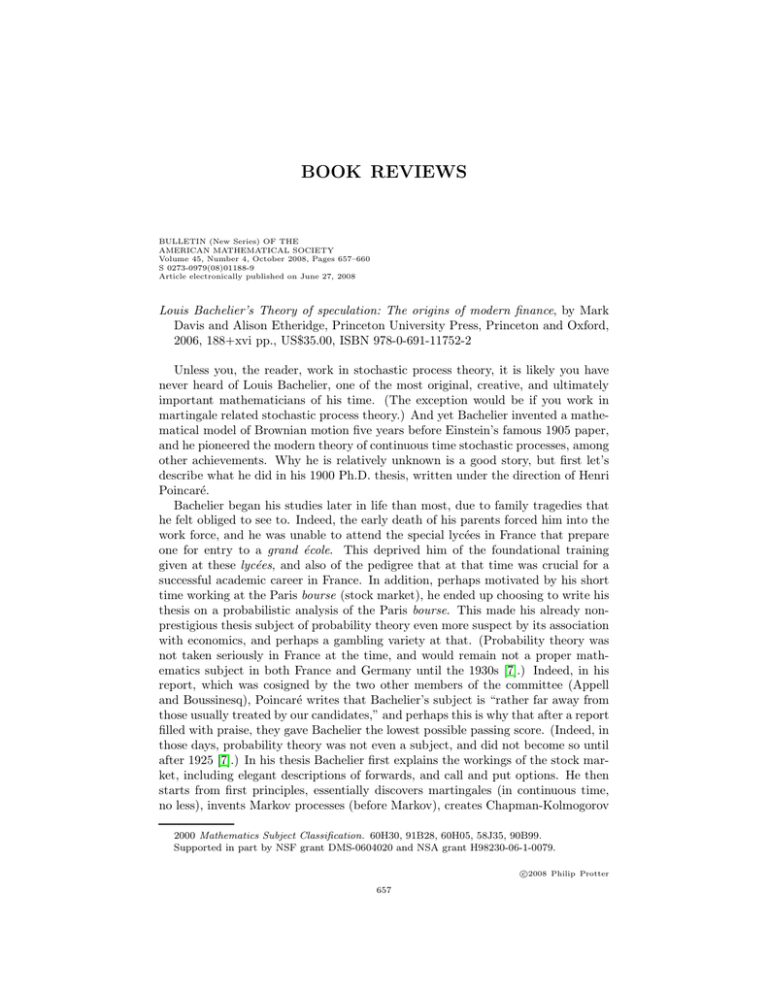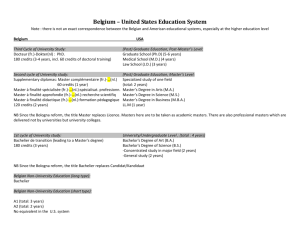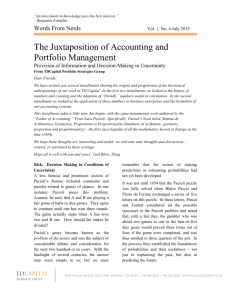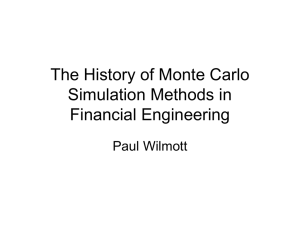BOOK REVIEWS
advertisement

BOOK REVIEWS BULLETIN (New Series) OF THE AMERICAN MATHEMATICAL SOCIETY Volume 45, Number 4, October 2008, Pages 657–660 S 0273-0979(08)01188-9 Article electronically published on June 27, 2008 Louis Bachelier’s Theory of speculation: The origins of modern finance, by Mark Davis and Alison Etheridge, Princeton University Press, Princeton and Oxford, 2006, 188+xvi pp., US$35.00, ISBN 978-0-691-11752-2 Unless you, the reader, work in stochastic process theory, it is likely you have never heard of Louis Bachelier, one of the most original, creative, and ultimately important mathematicians of his time. (The exception would be if you work in martingale related stochastic process theory.) And yet Bachelier invented a mathematical model of Brownian motion five years before Einstein’s famous 1905 paper, and he pioneered the modern theory of continuous time stochastic processes, among other achievements. Why he is relatively unknown is a good story, but first let’s describe what he did in his 1900 Ph.D. thesis, written under the direction of Henri Poincaré. Bachelier began his studies later in life than most, due to family tragedies that he felt obliged to see to. Indeed, the early death of his parents forced him into the work force, and he was unable to attend the special lycées in France that prepare one for entry to a grand école. This deprived him of the foundational training given at these lycées, and also of the pedigree that at that time was crucial for a successful academic career in France. In addition, perhaps motivated by his short time working at the Paris bourse (stock market), he ended up choosing to write his thesis on a probabilistic analysis of the Paris bourse. This made his already nonprestigious thesis subject of probability theory even more suspect by its association with economics, and perhaps a gambling variety at that. (Probability theory was not taken seriously in France at the time, and would remain not a proper mathematics subject in both France and Germany until the 1930s [7].) Indeed, in his report, which was cosigned by the two other members of the committee (Appell and Boussinesq), Poincaré writes that Bachelier’s subject is “rather far away from those usually treated by our candidates,” and perhaps this is why that after a report filled with praise, they gave Bachelier the lowest possible passing score. (Indeed, in those days, probability theory was not even a subject, and did not become so until after 1925 [7].) In his thesis Bachelier first explains the workings of the stock market, including elegant descriptions of forwards, and call and put options. He then starts from first principles, essentially discovers martingales (in continuous time, no less), invents Markov processes (before Markov), creates Chapman-Kolmogorov 2000 Mathematics Subject Classification. 60H30, 91B28, 60H05, 58J35, 90B99. Supported in part by NSF grant DMS-0604020 and NSA grant H98230-06-1-0079. c 2008 Philip Protter 657 658 BOOK REVIEWS equations (decades before Kolmogorov extended the Markov chain equations to continuous time), derives the Gaussian law through first principles in economics, was the first in France to connect Gaussian density to the heat equation and more generally Markov processes to partial differential equations (Rayleigh had done it earlier in England, but this work was unknown at the time in France). Further, he invents Brownian motion five years before Einstein (the work of Boltzmann, which influenced Einstein with his development of Brownian motion in 1905, was translated into French only in 1902 and 1905, after Bachelier’s thesis), and he studies path properties of Brownian motion, including symmetries such as a reflection principle, again decades earlier than others. And he does all this in his thesis of a mere 86 pages. His reasoning also leads to the notion of a risk neutral measure, although he does not really realize the importance of this. That he was studying probability was probably not a problem in Paris in the very early twentieth century, since men like Poincaré and Laplace were already invested in the subject. Yet he suffered greatly and was never able to achieve a position in Paris, to his lifelong regret. Indeed, he spent his career at the isolated and small provincial capital Besançon of the relatively poor province of Franche-Compté near Switzerland. In the words of Bernstein [1], Besançon is “about as provincial as provincial France can get.” At a key point in his career, when he applied for a position in Dijon, he appears to have been “black-balled,” by the mathematician Maurice Gevrey, who enlisted the willing help of no less a figure than the very powerful Paul Lévy. The excuse was that he had made a mistake (his calculations were off by a constant at one point in his thesis). In reality, he tended to write more like a physicist than a mathematician, and his heuristic manner of writing was misinterpreted by Gevrey, who was looking for reasons to exclude Bachelier in any event. In addition, Bachelier may have had a difficult personality, and that he was applying probability to the Paris bourse rather than, for example, to physics, may have played a significant role. Nevertheless, his role in the development of stochastic process theory was certainly known to A. N. Kolmogorov (who told Albert Shiryaev that Bachelier was a strong influence for him, according to footnote 31 of [7]) and later to J. Doob, both of whom referenced his works, and it seems to have been known to K. Itô as well, the creator of the Itô integral. But while his work received perfunctory acknowledgment, it was certainly not celebrated. It is a different story in economics, where Bachelier was roughly 60 years ahead of the times. Here his work was completely forgotten, and leading economists were unaware of his existence. Indeed, the Nobel prize winner and dean of American economics, Paul Samuelson, waged a decades long and at times lonely campaign to convince economists that using probability to model the stock market is a good idea. In the early 1960s the renowned statistician L. Jimmie Savage sent a flurry of postcards to economists alerting them to the existence and significance of Bachelier’s work. This was just what Samuelson needed to fortify his campaign, and the world of economics woke up to the achievements of Bachelier. This had fantastic consequences, since Black, Scholes, and Merton were all at MIT with Samuelson at the time, and inspired by the ideas of Bachelier, they created what is now known as the Black-Scholes model (more properly the Black-Scholes-Merton model) on the pricing and hedging of financial derivatives, which eventually led to a Nobel prize. Thus, very belatedly, Bachelier was recognized posthumously by economists, and is now appropriately appreciated by mathematicians. For economists, the renowned economist Paul Cootner said in 1964, “So outstanding is his work that we can BOOK REVIEWS 659 say that the study of speculative prices has its moment of glory at its moment of conception” [3]. The story of Bachelier, as sketched above, is a bit controversial. The facts are not in dispute, but their interpretation has different versions. The book of Bernstein [1] presents an interpretation slanted more towards Bachelier as the frustrated genius, ignored and spurned by his contemporaries. (This same viewpoint is presented in the excellent sketch of Bachelier’s life by Mandelbrot [6, pp. 392–394].) In contrast, the article by Courtault et al. [2], presents a more nuanced view and stresses how Bachelier’s work did in fact have profound influence upon subsequent work, especially in mathematics, where it was never forgotten, even if it was incontrovertibly not celebrated until quite recently. It was with great anticipation, therefore, that I began to read the book under review, hoping for insight into this mild controversy. It was a bit of a surprise, therefore, when I discovered that Davis and Etheridge do not tell the story of Bachelier at all. This is disappointing, but nevertheless the book has quite a lot to offer the reader. The central feature of the book by Davis and Etheridge is the reproduction of the French thesis of Bachelier, and with it a translation into English. While this is not the first time Bachelier’s thesis has been republished, or indeed even translated into English (see [4] which also has a nice translation and explanatory footnotes), it is the first time it has been published with quite such illuminating commentary. This is followed by the report (also translated) of Poincaré, Appell and Boussinesq, on the thesis. Within the English version of the thesis, the authors (renowned scholars themselves) take pains to explain in modern terms some of the archaic but quaint terms used by Bachelier, and in general give useful and insightful commentary when needed. They strike a perfect balance of giving minimal commentary, but enough all the same. The book is made special by the inclusion of two chapters on the post-Bachelier development of the theory. By “the theory,” I mean both the theory of stochastic integration and of mathematical finance, for the history of the two is intertwined. The development of stochastic integration began with N. Wiener when he tried in the 1920’s and 1930’s to develop a theory of filtering using Brownian motion as a heuristic integral of the nonexistent process “white noise.” (Actually, white noise does exist in the generalized function sense of Gelfand, for example.) When K. Itô finally succeeded to develop a true stochastic integral in the 1940’s, his inspiration came from a desire to give a new intuition for Markov processes and their applications to physics. When J. Doob, P.A. Meyer, and H. Kunita and S. Watanabe extended the Itô integral to martingales and eventually to semimartingales, their original motivation was to better understand probabilistic potential theory. But these insights, coming from electricity, physics, and even biology as W. Feller pointed out, were all of the same paradigmatic framework. Mathematical finance, in contrast, presented an intuition that was in many ways orthogonal to the established paradigm. This spurred the development of stochastic integration theory, as fresh insights led to new ideas and new theorems, in the grand tradition of mathematical progress. And, in turn, the new mathematical developments led to new insights in economic theory, as well, including the Black-Scholes-Merton formula, and the ability to develop Merton’s hedging ideas. As an example, it is hard to imagine having so elegant a proof that the price of an American call must be the same as the price of a European call in the absence of dividends, without the theory of martingales. (This is also known as Merton’s “no early exercise” theorem.) 660 BOOK REVIEWS It is not an easy task for Davis and Etheridge to trace out this development, and yet they make it look easy, with their graceful oscillations betwixt the mathematics and the economics. These chapters are an original contribution of the authors, and while they lean on the work of others before them (e.g., [5]), they put together the known history in an interesting and very readable manner. When the authors (quite prudently) stop at 1981, it leaves the reader hungry for more—for a history continuing up to the present day. The book ends up being both an informative and an interesting read for the novice and the expert alike. The life of Bachelier makes a good story. Due to family tragedies, he began his graduate career later in life than most, but nevertheless wrote a thesis under the direction of the legendary Henri Poincaré. He submitted his thesis in 1900, a probability-based analysis of the workings of the Paris bourse, or stock market. Today we can recognize his thesis as spectacular, but at the time he wrote it, the idea of applying probability theory to a question involving economics (and the stock market at that) was quite avant garde. In many countries even the use of probability theory would have been suspect, but of course he was in France, and both Laplace and Poincaré among others before him had established a certain legitimacy of probability as acceptable (if perhaps B list or C list) mathematics. The fact that his thesis ultimately connected to the Gaussian density (then known as Gauss’ law of errors) did not hurt. References [1] Peter L. Bernstein, Capital Ideas: The Improbable Origins of Modern Wall Street, The Free Press, New York, 1993. [2] J-M. Courtault, Y. Kabanov, B. Bru, P. Crépel, I. Lebon, and A. Le Marchand, “Louis Bachelier: On the Centenary of Théorie de la Speculation” Mathematical Finance, 10 (2000), 341–353. MR1800320 (2001i:91004) [3] Quoted in Bernstein, page 18. [4] P. Cootner, editor, The Random Character of Stock Market Prices, MIT Press, Cambridge, MA, 1964. [5] R. Jarrow and P. Protter, “A Short History of Stochastic Integration and Mathematical Finance: The Early Years, 1880–1970” in the Herman Rubin Festschrift, IMS Lecture Notes 45 (2004), 75–91. MR2126888 (2006a:60005) [6] B. Mandelbrot, The Fractal Geometry of Nature, W.H. Freeman and Co, 1982. MR665254 (84h:00021) [7] M. Taqqu, “Bachelier and his times: A conservation with Bernard Bru” Finance and Stochastics, 5 (2001), 3–32. MR1807874 (2001i:01043) Philip Protter Cornell University





